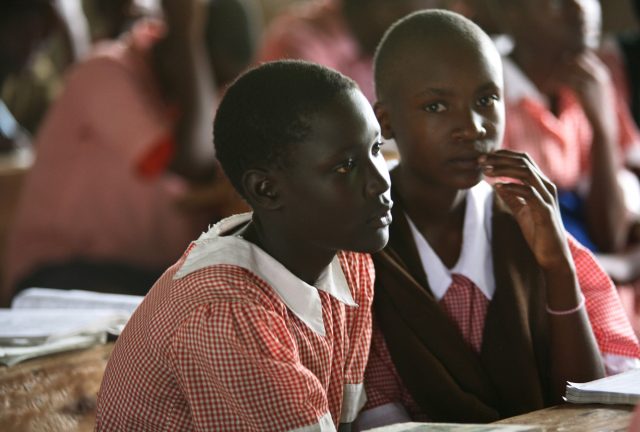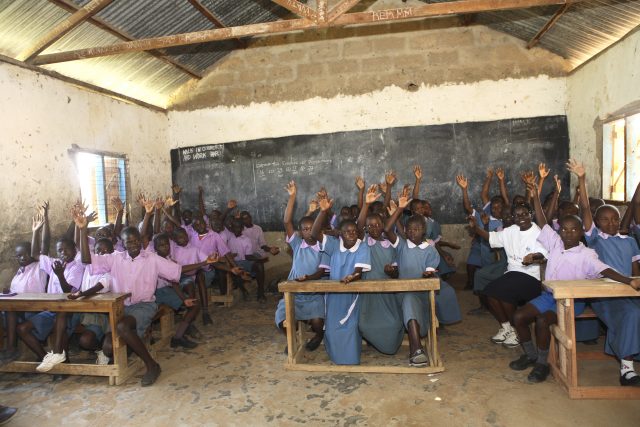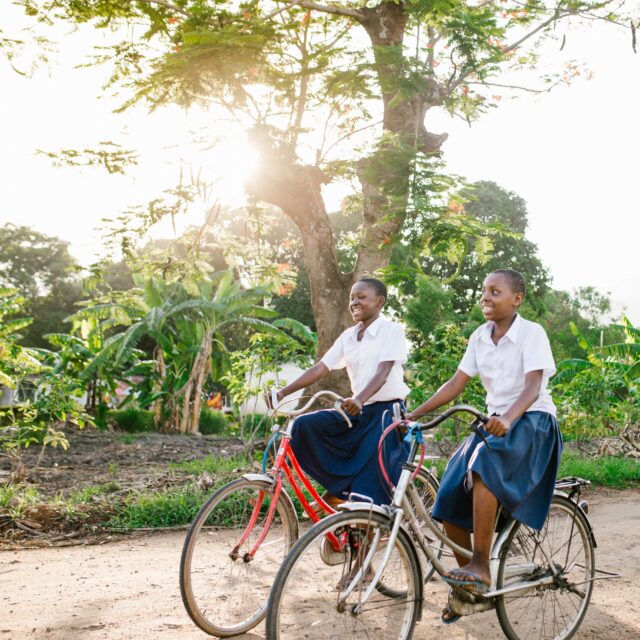This post by Meagan Neal, Abdul Latif Jameel Poverty Action Lab (J-PAL), is the third post in a blog series on overcoming barriers to girls’ education, based on J-PAL’s new Bulletin on improving student enrollment and attendance. Read the first post summarizing these barriers here and learn more about the first-order barrier of travel time here.
In 2003 in western Kenya, a school uniform cost $6. This might seem like a small cost—but for poor families, it was a substantial out-of-pocket expense. Meanwhile, many girls dropped out before the end of primary school. Could this cost be one of the reasons?
To try to address the problem, an NGO began distributing free primary school uniforms. Would receiving a uniform actually have an impact on girls’ lives?

(Photo credit: Aude Guerrucci/J-PAL/IPA)
To find out, a group of researchers partnered with the NGO and the government to conduct a randomized evaluation—a type of impact evaluation that allows us to scientifically test whether a program has a positive or negative impact, and quantify how large those impacts are.
As part of the evaluation, a large group of 6th-grade girls was randomly split into groups. One group got free uniforms for two years, while another group simply went about their lives as usual. Years later, researchers followed up with families of girls who had received uniforms, and girls who did not, to see whether the two groups had different outcomes.
What they found was impressive. Five years on, girls who had received a free school uniform were 17% less likely to have dropped out of primary school. They were 20% less likely to have been married and 17% less likely to have become pregnant while they were teenagers.
The impact was clear, which brings us to the question: why? How could such a low-cost, one-time intervention have such a large impact on a girls’ life trajectory?
Costs—large and small—as barriers to girls’ education
Earlier this year, my colleagues and I at the Abdul Latif Jameel Poverty Action Lab (J-PAL) reviewed nearly 60 randomized evaluations of programs designed to increase student enrollment and attendance, answering questions such as the one above. Taken together, this body of rigorous research provides general lessons that can help policymakers, NGOs, private firms, and others decide whether to move forward on—or cut back—a certain policy or program.
Across these studies, a clear message stood out: The perceived costs and benefits of schooling are a major factor in parents’ and students’ education decisions.

(Photo credit: Aude Guerrucci/J-PAL/IPA)
When costs are high and benefits aren’t clearly understood, parents are less likely to send their kids to school, and kids are less likely to want to attend. The benefits of education come mostly in the future, but the costs are immediate and top-of-mind. As girls get older, they may also have more chores at home, meaning that their school attendance during the day further adds to the household burden.
This means that after we make sure school is accessible, making sure school is affordable is the next step to getting girls in school.
In high-income countries, public schools are essentially free. This is not the case in many of the world’s poorest countries, especially at the secondary (high school) level, where annual public school fees can cost as much as one-third of an average family’s yearly income.
Reducing these costs has consistently been shown to help get more girls into the classroom. In Ghana, for example, giving high school scholarships to students who had passed an entrance exam but couldn’t afford to attend led to large increases in enrollment and educational attainment. Eight years later, 68% of girls who had won scholarships had completed senior high school, compared to 42% of the non-winners. Scholarships also closed the gender gap in tertiary education enrollment, with girls catching up to boys. And impacts weren’t only confined to education: The scholarships led to fewer girls marrying and having kids in their teens.

(Photo credit: Aude Guerrucci/J-PAL/IPA)
But while it may be obvious that families can’t always afford large school fees, data shows that even relatively small costs—such a $6 uniform, a school lunch, books or school supplies—can keep kids out of school.
Just as providing school uniforms in Kenya reduced dropout, paying for school meals in Burkina Faso and Uganda helped increase girls’ attendance. Programs that eliminate similar costs, or provide small cash benefits, can make all the difference.
The cost of a school uniform or lunch shouldn’t stand between a girl and her future. By eliminating the immediate costs of schooling where we can, we will move toward a world in which every girl gets the opportunities she deserves.
Curious about other barriers to girls’ education? Check out J-PAL’s overview post on barriers to girls’ schooling, learn about the first-order barrier of distance, and stay tuned for the next installment. See the full J-PAL bulletin here, and learn more about J-PAL’s work in education here.
Have a question for J-PAL on how to break barriers to girls’ schooling? Tweet your question @JPAL_Global using the hashtag #askJPAL.



